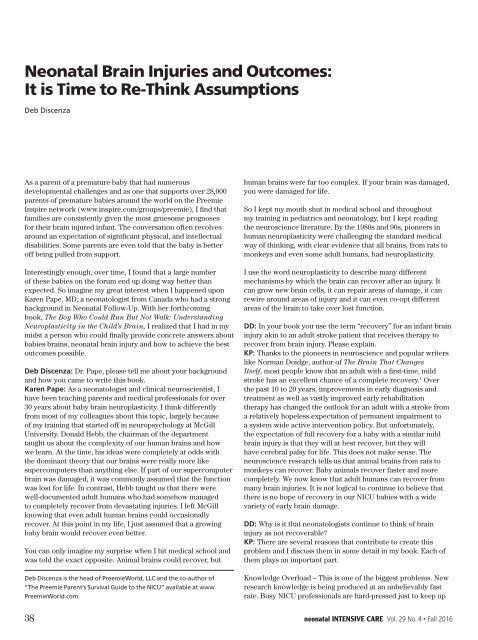INTENSIVE CARE
8dI2AMDUa
8dI2AMDUa
You also want an ePaper? Increase the reach of your titles
YUMPU automatically turns print PDFs into web optimized ePapers that Google loves.
Neonatal Brain Injuries and Outcomes:<br />
It is Time to Re-Think Assumptions<br />
Deb Discenza<br />
As a parent of a premature baby that had numerous<br />
developmental challenges and as one that supports over 28,000<br />
parents of premature babies around the world on the Preemie<br />
Inspire network (www.inspire.com/groups/preemie), I find that<br />
families are consistently given the most gruesome prognoses<br />
for their brain injured infant. The conversation often revolves<br />
around an expectation of significant physical, and intellectual<br />
disabilities. Some parents are even told that the baby is better<br />
off being pulled from support.<br />
Interestingly enough, over time, I found that a large number<br />
of these babies on the forum end up doing way better than<br />
expected. So imagine my great interest when I happened upon<br />
Karen Pape, MD, a neonatologist from Canada who had a strong<br />
background in Neonatal Follow-Up. With her forthcoming<br />
book, The Boy Who Could Run But Not Walk: Understanding<br />
Neuroplasticity in the Child’s Brain, I realized that I had in my<br />
midst a person who could finally provide concrete answers about<br />
babies brains, neonatal brain injury and how to achieve the best<br />
outcomes possible.<br />
Deb Discenza: Dr. Pape, please tell me about your background<br />
and how you came to write this book.<br />
Karen Pape: As a neonatologist and clinical neuroscientist, I<br />
have been teaching parents and medical professionals for over<br />
30 years about baby brain neuroplasticity. I think differently<br />
from most of my colleagues about this topic, largely because<br />
of my training that started off in neuropsychology at McGill<br />
University. Donald Hebb, the chairman of the department<br />
taught us about the complexity of our human brains and how<br />
we learn. At the time, his ideas were completely at odds with<br />
the dominant theory that our brains were really more like<br />
supercomputers than anything else. If part of our supercomputer<br />
brain was damaged, it was commonly assumed that the function<br />
was lost for life. In contrast, Hebb taught us that there were<br />
well-documented adult humans who had somehow managed<br />
to completely recover from devastating injuries. I left McGill<br />
knowing that even adult human brains could occasionally<br />
recover. At this point in my life, I just assumed that a growing<br />
baby brain would recover even better.<br />
You can only imagine my surprise when I hit medical school and<br />
was told the exact opposite. Animal brains could recover, but<br />
Deb Discenza is the head of PreemieWorld, LLC and the co-author of<br />
“The Preemie Parent’s Survival Guide to the NICU” available at www.<br />
PreemieWorld.com.<br />
human brains were far too complex. If your brain was damaged,<br />
you were damaged for life.<br />
So I kept my mouth shut in medical school and throughout<br />
my training in pediatrics and neonatology, but I kept reading<br />
the neuroscience literature. By the 1980s and 90s, pioneers in<br />
human neuroplasticity were challenging the standard medical<br />
way of thinking, with clear evidence that all brains, from rats to<br />
monkeys and even some adult humans, had neuroplasticity.<br />
I use the word neuroplasticity to describe many different<br />
mechanisms by which the brain can recover after an injury. It<br />
can grow new brain cells, it can repair areas of damage, it can<br />
rewire around areas of injury and it can even co-opt different<br />
areas of the brain to take over lost function.<br />
DD: In your book you use the term “recovery” for an infant brain<br />
injury akin to an adult stroke patient that receives therapy to<br />
recover from brain injury. Please explain.<br />
KP: Thanks to the pioneers in neuroscience and popular writers<br />
like Norman Doidge, author of The Brain That Changes<br />
Itself, most people know that an adult with a first-time, mild<br />
stroke has an excellent chance of a complete recovery. 1 Over<br />
the past 10 to 20 years, improvements in early diagnosis and<br />
treatment as well as vastly improved early rehabilitation<br />
therapy has changed the outlook for an adult with a stroke from<br />
a relatively hopeless expectation of permanent impairment to<br />
a system wide active intervention policy. But unfortunately,<br />
the expectation of full recovery for a baby with a similar mild<br />
brain injury is that they will at best recover, but they will<br />
have cerebral palsy for life. This does not make sense. The<br />
neuroscience research tells us that animal brains from rats to<br />
monkeys can recover. Baby animals recover faster and more<br />
completely. We now know that adult humans can recover from<br />
many brain injuries. It is not logical to continue to believe that<br />
there is no hope of recovery in our NICU babies with a wide<br />
variety of early brain damage.<br />
DD: Why is it that neonatologists continue to think of brain<br />
injury as not recoverable?<br />
KP: There are several reasons that contribute to create this<br />
problem and I discuss them in some detail in my book. Each of<br />
them plays an important part.<br />
Knowledge Overload – This is one of the biggest problems. New<br />
research knowledge is being produced at an unbelievably fast<br />
rate. Busy NICU professionals are hard-pressed just to keep up<br />
38 neonatal <strong>INTENSIVE</strong> <strong>CARE</strong> Vol. 29 No. 4 • Fall 2016


